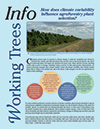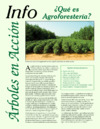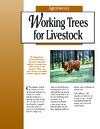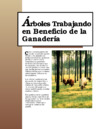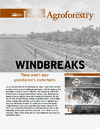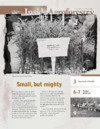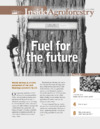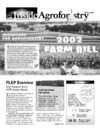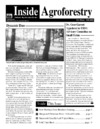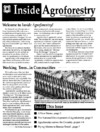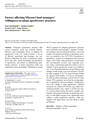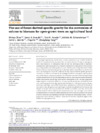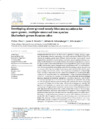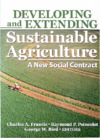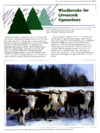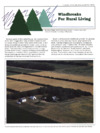Windbreaks
Windbreaks are linear plantings of trees and shrubs designed to provide economic, environmental and community benefits. The primary purpose of most windbreaks is to slow the wind which creates a more beneficial condition for soils, crops, livestock, wildlife and people. Windbreaks, sometimes called shelterbelts, can also function in ways not related to wind reduction. Non-wind related purposes include shade for livestock, visual screening, aesthetics, recreational opportunities, and wood and nontimber forest products. Windbreaks have also been recognized for their value in providing ecosystem services, which often extend beyond the farm. Benefits include enhancement of biodiversity, wildlife habitat, carbon storage, pollinator habitat, and soil and water quality protection.
Increasingly windbreaks are being designed to provide additional sources of income and products that can be used in the farm operation.
Windbreaks can be and often are designed to serve more than one purpose. However, windbreaks are not a one size fits all practice. The location, orientation to the wind, height, width, density and species selection all play a role in determining the benefits that the windbreak will provide.
There are several types of windbreaks. Field windbreaks protect a variety of wind-sensitive crops, control soil wind erosion, increase crop yields, and increase bee pollination and irrigation and pesticide effectiveness. Field windbreaks can also be designed to spread snow evenly across a field, increasing spring soil moisture. Livestock windbreaks help reduce mortality from cold weather, animal stress, and feed consumption, all of which lead to increased weight gain and milk production. Windbreaks also help reduce visual impacts, noise, and odors from livestock operations. Living snow fences keep roads clear of drifting snow and increase driving safety. Farmstead windbreaks reduce heating costs and improve outdoor working conditions.

Increasingly windbreaks are being designed to provide additional sources of income. Some trees and shrubs can produce fruits, nuts, fuel, fodder or materials for crafts that can be sold or processed in order to diversify farm income. In these cases the crop that is harvested from the trees and shrubs in a manner that does not impair the shelterbelt function. Careful design is required to reduce potential conflicts between management of the crop field and the windbreak.
Some other specialized windbreaks include pollinator habitat and field buffers for organic production. Pollinators can be supported by including a variety of plants that bloom at different times to provide food over a longer period of time. Native pollinators can also be supported by choosing plants that are used for bee nesting and merely by providing undisturbed soil for ground nesting bees. Shelterbelts can also be designed to intercept pesticides and chemical laden dust to protect organic production fields and active pollinators, both wild and domesticated.
Currently, significant work is being carried out by NAC and its partners to support windbreak inventory, establishment, and renovation. Windbreaks of the Great Plains is a Story Map that visually depicts the history, status, and opportunities of windbreaks in this region. Another web app, Trees Outside Forests Interactive Web Viewer, highlights agroforestry in the Northern Plains states including high-resolution tree cover maps.
A comprehensive synthesis of windbreak adoption in the U.S. by staff of the National Agroforestry Center found that producers use windbreaks primarily for indirect economic benefits (soil erosion control, livestock protection, wind protection and snow control). This was followed by direct agricultural benefits (increased crop and livestock production) and intrinsic values (aesthetics and wildlife habitat). Across the 32 windbreak studies in this review, which covered U.S. producer opinions from 1949-2020, windbreak satisfaction was incredibly high, ranging from 72-99%.
Windbreaks Publications
Information Sheets
Infosheet

Infosheet

Infosheet

Infosheet

Infosheet

Infosheet

Infosheet

Infosheet

Infosheet

Infosheet

Infosheet

Infosheet

Infosheet

Infosheet

Infosheet

Infosheet

Brochures
Brochure

Brochure

Brochure

Brochure

Brochure

Brochure

Brochure

Brochure

Brochure

Brochure

Brochure

Inside Agroforestry
Inside Agroforestry

Inside Agroforestry

Inside Agroforestry

Inside Agroforestry

So Many Trees To Choose From
DownloadInside Agroforestry

Inside Agroforestry

Why Agroforestry?
DownloadInside Agroforestry

Inside Agroforestry

Learn How You Can Use Agroforestry To Help Pollinators
DownloadInside Agroforestry

Inside Agroforestry

Finding Agroforestry In The 2014 Farm Bill
DownloadInside Agroforestry

Locally Sourced
DownloadInside Agroforestry

Helping Wildlife Helps You!
DownloadInside Agroforestry

Inside Agroforestry

Extreme Weather
DownloadInside Agroforestry

Windbreaks: These Aren't Your Grandfather's Shelterbelts
DownloadInside Agroforestry

Now Is The Time For Agroforestry!
DownloadInside Agroforestry

Breathe In. Okay, Now Breathe Out
DownloadInside Agroforestry

Small, But Mighty
DownloadInside Agroforestry

Beyond The Fence Line
DownloadInside Agroforestry

Diamonds In The Rough
DownloadInside Agroforestry

Fuel For The Future
DownloadInside Agroforestry

A Diverse Portfolio
DownloadInside Agroforestry

Northern Exposure: Agroforestry In Canada
DownloadInside Agroforestry

Tool Talk
DownloadInside Agroforestry

Windbreaks
DownloadInside Agroforestry

2002 Farm Bill
DownloadInside Agroforestry

Odor: Can Trees Make A Difference?
DownloadInside Agroforestry

Getting Buffers On The Ground: A Group Effort
DownloadInside Agroforestry

Alley Cropping: 20/20 Vision For Farming's Future
DownloadInside Agroforestry

... Including The Carbon Sink
DownloadInside Agroforestry

Spring 2000
DownloadInside Agroforestry

Fall/Winter 1999-2000
DownloadInside Agroforestry

Spring 1998
DownloadInside Agroforestry

Winter 1997
DownloadInside Agroforestry

Spring 1997
DownloadInside Agroforestry

Summer 1997
DownloadInside Agroforestry

Winter/Spring 1996
DownloadInside Agroforestry

Fall 1996
DownloadInside Agroforestry

Fall 1995
DownloadInside Agroforestry

Spring 1995
DownloadInside Agroforestry

Summer 1995
DownloadInside Agroforestry

Spring 1994
DownloadInside Agroforestry

Summer 1994
DownloadInside Agroforestry

Fall 1994
DownloadInside Agroforestry

Winter 1993
DownloadInside Agroforestry

Summer 1993
DownloadInside Agroforestry

Fall 1993
DownloadInside Agroforestry

Winter/Spring 1993
DownloadInside Agroforestry

Fall 1992
Download
Agroforestry Notes
Agroforestry Note

Windbreaks And Hedgerows In Vineyards
DownloadAgroforestry Note

Alley Cropping In Vineyards
DownloadAgroforestry Note

Silvopasture: An Agroforestry Practice
DownloadAgroforestry Note

Windbreaks: An Agroforestry Practice
DownloadAgroforestry Note

Using Agroforestry Practices To Reduce Pesticide Risks To Pollinators & Other Agriculturally Beneficial Insects
DownloadAgroforestry Note

Agroforestry Note

Using Agroforestry To Buffer Noise
DownloadAgroforestry Note

Agroforestry Note

Windbreak Density: Rules Of Thumb For Design
DownloadAgroforestry Note

Waterbreaks: Managed Trees For The Floodplain
DownloadAgroforestry Note

Outdoor Living Barn: A Specialized Windbreak
Download
Research
Research

Factors Affecting Missouri Land Managers’ Willingness-to-Adopt Agroforestry Practices
DownloadResearch

Agroforestry Across The United States: Results Of The 2022 Census Of Agriculture
DownloadResearch

Quantifying Greenhouse Gas Sources And Sinks In Cropland And Grazing Land Systems
DownloadResearch

A Cultural Landscape Archive: Digitizing The New Deal’s Prairie States Forestry Project
DownloadResearch

Windbreaks Of The Great Plains Story Map
DownloadResearch

Windbreaks In The United States: A Systematic Review Of Producer-reported Benefits, Challenges, Management Activities And Drivers Of Adoption
DownloadResearch

Temperate Agroforestry Systems & Insect Pollinators: A Review
DownloadResearch

High-resolution Land Cover Of Kansas
DownloadResearch

Diseases Of Trees In The Great Plains
DownloadResearch

A Win-win On Agricultural Lands: Creating Wildlife Habitat Through Agroforestry
DownloadResearch

Analyzing The Uncertainties In Use Of Forest-derived Biomass Equations For Open-grown Trees In Agricultural Land
DownloadResearch

Working Trees: Supporting Agriculture And Healthy Landscapes
DownloadResearch

Simulating The Dynamics Of Linear Forests In Great Plains Agroecosystems Unfer Changing Climates
DownloadResearch

Enhancing Ecosystem Services: Designing For Multifunctionality
DownloadResearch

A Role For Agroforestry In Forest Restoration In The Lower Mississippi Alluvial Valley
DownloadResearch

A Spatial Model Approach For Assessing Windbreak Growth And Carbon Stocks
DownloadResearch

The Use Of Forest-derived Specific Gravity For The Conversion Of Volume To Biomass For Open-grown Trees On Agricultural Land
DownloadResearch

Creatively Communicating Conservation Complexity
DownloadResearch

Agroforestry: Working Trees For Sequestering Carbon On Agricultural Lands
DownloadResearch

Filling The Gap: Improving Estimates Of Working Tree Resources In Agricultural Landscapes
DownloadResearch

Buffer And Vegetative Filter Strips
DownloadResearch

Developing Above-ground Woody Biomass Equations For Open-grown, Multi-stemmed Tree Species: Shelterbelt-grown Russian-olive
DownloadResearch

Managing Agricultural Landscapes For Environmental Quality: Strengthening The Science Base
DownloadResearch

Perennial Crops For Bio-fuels And Conservation
DownloadResearch

Developing And Extending Sustainable Agriculture: A New Social Contract
DownloadResearch

Visualizing Agroforestry Alternatives Or Pixel This!
DownloadResearch

Tool Time: Melding Watershed And Site Goals On Private Lands
DownloadResearch

Visualizing Food And Farm
DownloadResearch

Inventorying Trees In Agricultural Landscapes: Towards An Accounting Of Working Trees
DownloadResearch

Picture This
DownloadResearch

Agroforestry-Working Trees For Sequestering Carbon On Ag-Lands
DownloadResearch

Computer-based Tools For Decision Support In Agroforestry: Current State And Future Needs
DownloadResearch

CBD Technical Series No. 10 - Interlinkages Between Biological Diversity And Climate Change
DownloadResearch

Agroforestry And GIS: Achieving Land Productivity And Environmental Protection
DownloadResearch

Alteration Of Soil Water Content Consequent To Root-pruning At A Windbreak/crop Interface In Nebraska, USA
DownloadResearch

Agroforestry: Mapping The Way With GIS
DownloadResearch

Ecobelts: Reconnecting Agriculture And Communities
DownloadResearch

Ecobelts: Reconnecting Agriculture And Communities - Case Studies
DownloadResearch

An Ecological Foundation For Temperate Agroforestry
DownloadResearch

Perspective: Agroforestry And Sustainability: Making A Patchwork Quilt
Download
More Publications
More Publications

Land Access Profiles
DownloadMore Publications

Guide To USDA Agroforestry Research Funding Opportunities
DownloadMore Publications

Inspirations For Creating A Long-Term Agricultural Lease For Agroforestry: A Workbook
DownloadMore Publications

More Publications

More Publications

More Publications

More Publications

Buffers For Biomass Production In Temperate European Agriculture: A Review And Synthesis On Function, Ecosystem Services And Implementation
DownloadMore Publications

Profitable Farms And Woodlands
DownloadMore Publications

More Publications

Green Infrastructure: Designing With Nature
DownloadMore Publications

Agroforestry In The United States: Research And Technology Transfer Needs For The Next Millenium
DownloadMore Publications

More Publications

RC & D Survey Of Agroforestry Practices
DownloadMore Publications

Living Snow Fences
DownloadMore Publications

More Publications

Integrating Agroforestry Into USDA Programs
DownloadMore Publications

More Publications

More Publications

Working Trees Coloring Book
DownloadMore Publications

More Publications

More Publications

More Publications

More Publications

More Publications

More Publications

Windbreaks For Conservation
Download



